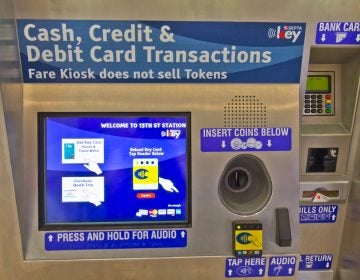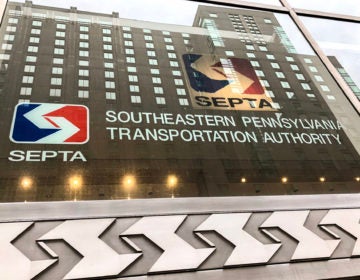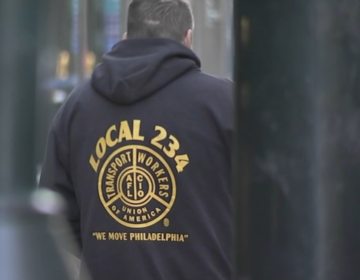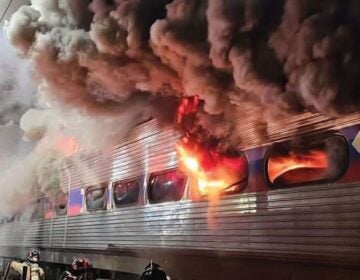Philly business leaders are now pushing harder to restore SEPTA funding as the CEO prepares to leave
Business leaders were asked by the region’s largest chamber of commerce to advocate for politicians to pass a bill that could stop the transit agency’s austerity measures.
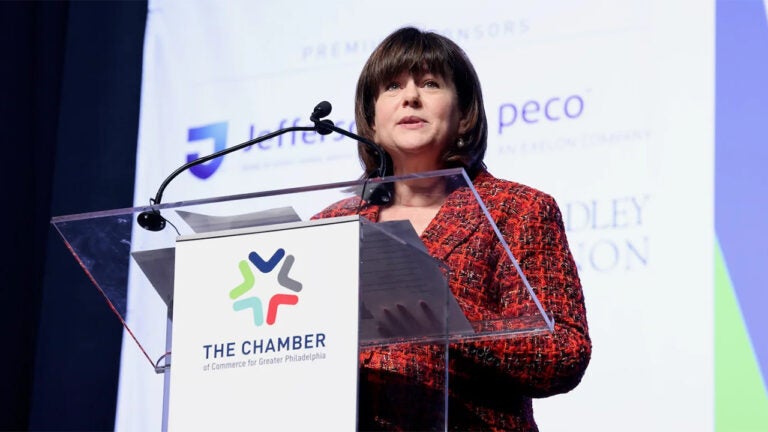
Chellie Cameron, president and chief executive officer of the Chamber of Commerce of Greater Philadelphia speaks at the 2024 annual meeting at the. Pennsylvania. Conventiion Center. (Emma Lee/WHYY)
Have a question about Philly’s neighborhoods or the systems that shape them? PlanPhilly reporters want to hear from you! Ask us a question or send us a story idea you think we should cover.
Philadelphia’s transit agency SEPTA is under immense pressure to get it right.
And there’s one more organized group that wants a seat at the decision making table, The Chamber of Commerce for Greater Philadelphia.
The plan to support SEPTA’s fight to get more taxpayer funding was already in the works when CEO Leslie Richards announced her departure from her post.
Regardless, at the chamber’s annual meeting where about 1,500 business professionals showed up, Chamber CEO Chellie Cameron asked for their help to sign a petition to lobby politicians for more support.
After her speech, Cameron said that business leaders care about infrastructure like transit because it’s critical for a thriving economy.

Without a reliable and functional transit system, Cameron said she envisions a very different reality.
“This city would gridlock. We don’t have enough parking, traffic would be a nightmare,” she said.
But Richards, who led the transit agency through the depths of the COVID-19 pandemic nearly five years ago, won’t be at the helm for much longer. She’s stepping down from her role at the transit agency on Nov. 29 to focus on expanding her position as an academic at the University of Pennsylvania.
On my way to the @ChamberPHL annual meeting today y’all. Word on the street is that @SEPTA will be a hot topic. Be sure to follow along @WHYYNews for more. pic.twitter.com/Ty79ufnMEo
— Kristen Mosbrucker-Garza (@k_mosbrucker) October 25, 2024
Richards told WHYY News that she ‘felt the love’ Friday at the chamber event.
“It was just so fantastic to see everyone taking their phones out making sure they got that QR code and letting their elected officials know that SEPTA is critical in this area,” she said. “I feel the SEPTA love today, big and strong. It feels pretty wonderful.”
Now the search for a new leader is on once again and the board of directors will be in charge.
As for the next SEPTA executive, Cameron said the chamber recognizes that “it’s a lot of work for whoever is in the job, to be able to navigate us through getting the funding that we need and to be able to expand the system.”
And that the chamber is “on standby ready to work with them.”
Cameron said she regularly rides the SEPTA system, mostly the bus as a commuter into Center City.
The transit system faces a $240 million budget shortfall after COVID-19 funding dried up. State leaders chipped in some as a temporary measure but it’s not enough to plug the gap.
There’s a plethora of businesses located just outside Philadelphia city limits but well within the SEPTA transportation network, which reaches deeply into the suburbs.
Commuter patterns show that often lower income tax bracket workers in the city and the nearby suburban communities will take public transit, as will college students, university or hospital employees, older adults and people with disabilities. Then occasionally, especially when on vacation, so will international and regional travelers.
SEPTA’s new fare hikes will make some riders on the outer rings of its service area pay more but some riders say they want inner city residents to pay their fair share.
All those groups have different needs from SEPTA, with different on-demand schedules, and reliability is the key factor for their decision to ride or not.
For business travelers, it’s not only reliability and access, but safety for themselves and their employees is paramount.
While many business professionals prefer to drive because of tight schedules packed with meetings and other responsibilities – others prioritize supporting SEPTA and it works for them.
“I’m a SEPTA power user. My son loves trains so sometimes we catch them just for fun,” said
Kenyatta James, deputy executive director at the Economy League of Greater Philadelphia. “But I take the train or the bus to work most days or when I take my son to school.”

While there’s fewer daily white collar job commuters from the suburbs into Center City than five years ago, the demand for rapid and reliable transportation is still expected, especially for business travelers who use the service as a connection route between Washington and New York City, with pit stops and transfers in Philadelphia and New Jersey.
“I take the subway mostly because I live close to it. So it’s always easy and convenient and the temperature is going to be a little bit more under control. On the train platform, it’s about the same temperature all the time and it is still generally faster [than sitting in traffic],” James said.
He supports the renewed advocacy for more public sector SEPTA investment. There’s so much opportunity, like the plans on the Broad Street Subway reconnection along Lehigh Avenue where Amtrak and SEPTA’s regional rail have plans to refurbish the North Philadelphia station, he said.
“On the East Coast we have a lot of transit infrastructure that if rehabbed or supported properly could be put back into use and allow for a drastic increase in commuter traffic, increasing people’s ability to get around without driving,” he said. “But a lot of these decisions are not made by people that need the trains. Statewide politics can make the situation a lot more difficult than it needs to be.”
For the annual chamber event, an employee with Philadelphia-based Ampro, a custom screen-printing and embroidery business, decided to take an Uber that morning, but she usually hitches a public transit ride.
“The train and the trolley, usually not the bus. I’ll probably walk over taking the bus,” said Erica Simmers, account manager with Ampro. “[The bus] is a little more cramped sometimes. The train feels like you’re getting there faster.”
As it stands, not all rider groups across the region pay the same share of taxes to support such a service, some suburban and rural communities argue there’s not enough service to justify paying for much of anything, let alone riding the trains, trolleys, subway cars and buses on a regular basis.
For Dr. Shirlana Dash, CEO of Self Inc. who works to reduce housing insecurity for vulnerable residents, – she lives within city limits but more often than not commutes in her vehicle and parks in a garage instead of using SEPTA.

For the Philadelphia Convention Center event, she was able to walk from her office.
“I haven’t taken SEPTA in a while, my impression would be it’s kind of old but the subways are very accessible but probably not as comprehensive as the New York [City] train system,” Dr. Dash said. “I work late at night and I prefer being safe. So safe for me is parking in the garage and getting right home, I work late hours.”
Another issue is that SEPTA is at the whim of a state legislature with representatives across the commonwealth in communities where it has never served.
Despite strong support from Gov. Josh Shapiro in recent years, representatives could not justify to their communities that significant permanent support from the rest of the state taxpayers would be worth it, for fear of being voted out of office.
The federal government is banking that its investments in PENNDOT, which are then in turn investments in SEPTA, will convince reluctant travelers on I-76, especially commuters, from clogging that critical arterial road.
“Ultimately it’s good for the environment, it’s good for business and it’s good for the region,” Cameron, the chamber CEO, said about fully funding SEPTA.

Get daily updates from WHYY News!
WHYY is your source for fact-based, in-depth journalism and information. As a nonprofit organization, we rely on financial support from readers like you. Please give today.



